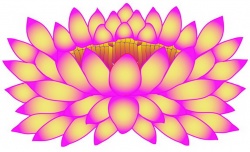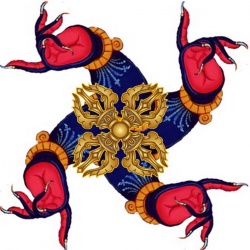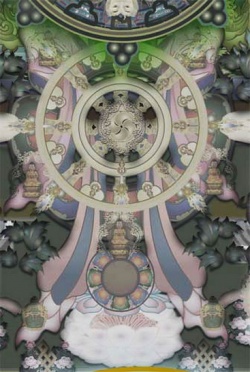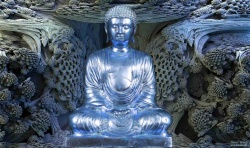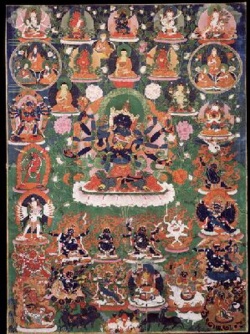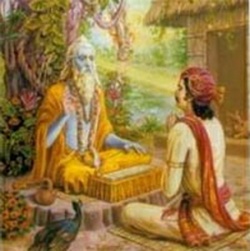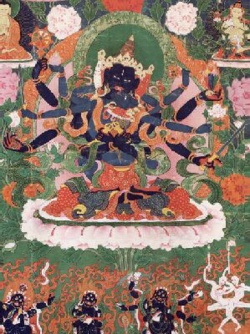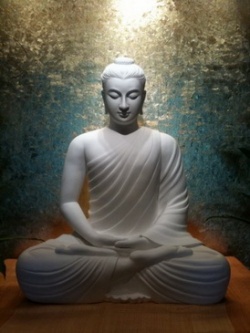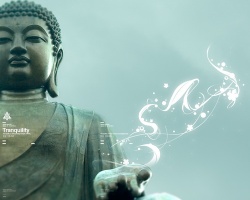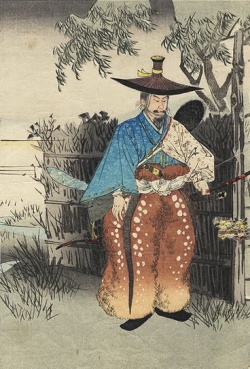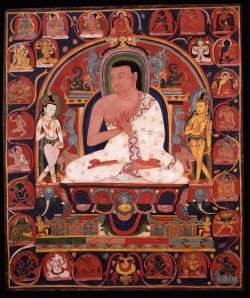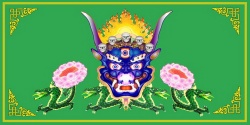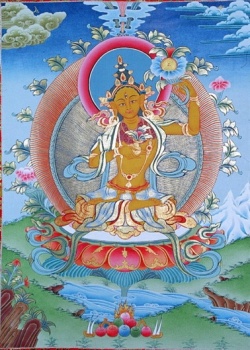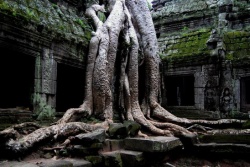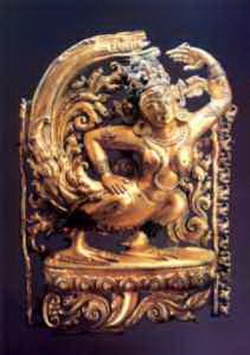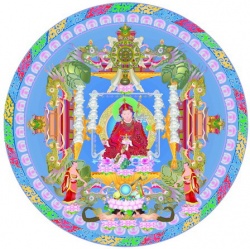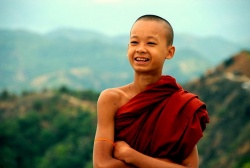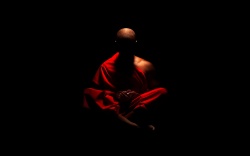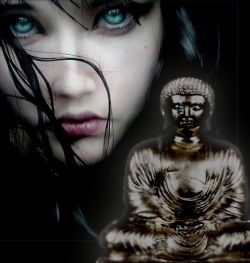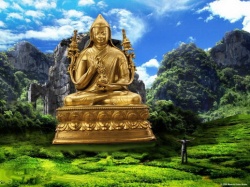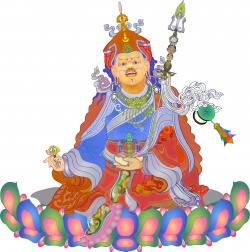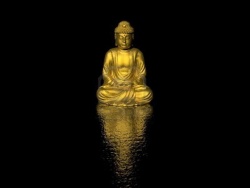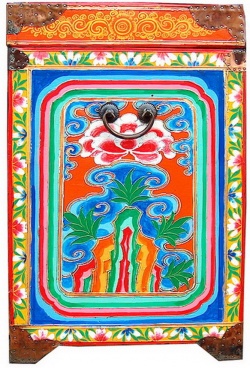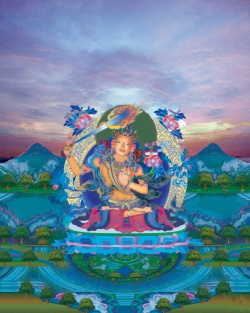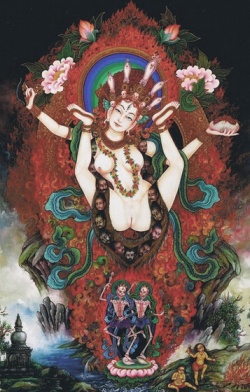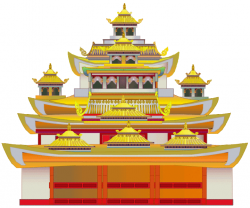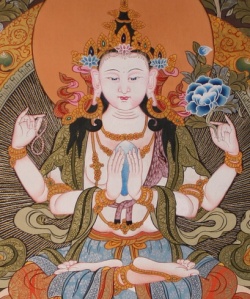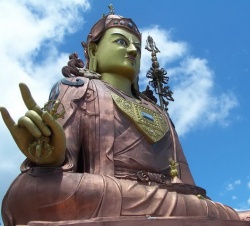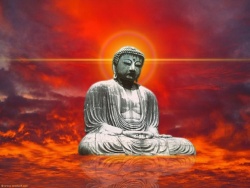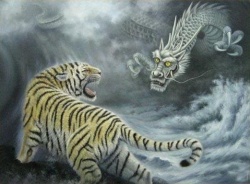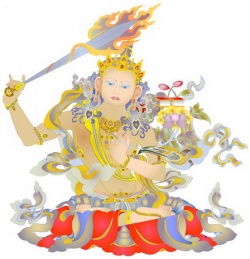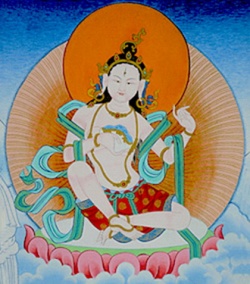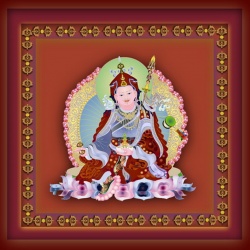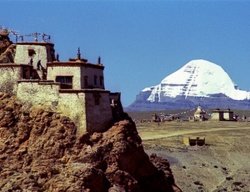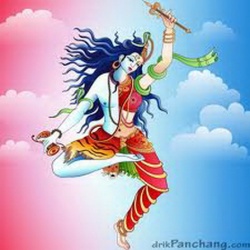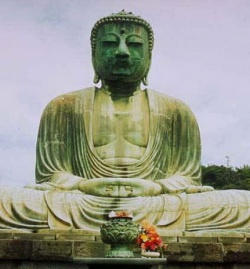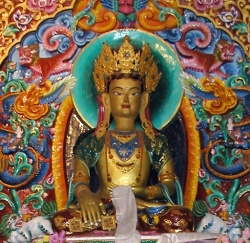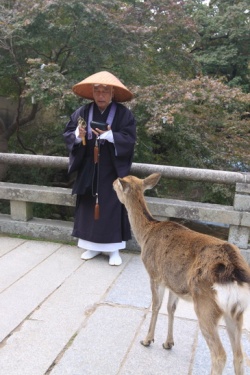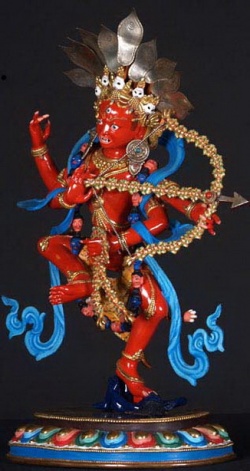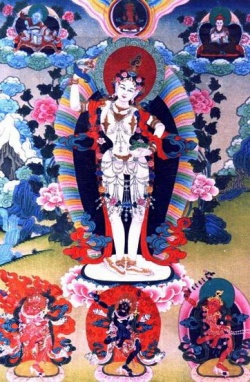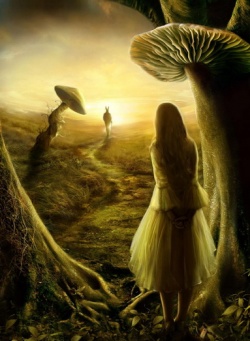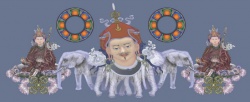The Dharma Flower Sutra seen through the Oral Transmission of Nichiren Daishōnin: The Eleventh Chapter on Seeing the Vision of the Stupa made of Precious Materials
The Dharma Flower Sutra
seen through the Oral Transmission of
Nichiren Daishōnin
The first important point, concerning the title of this chapter “on Seeing the Vision of the Stupa made of Precious Materials”.
The Universal Teacher Tendai (T’ien T’ai), in the eighth volume of his Notes on the Textual Explanation of the Dharma Flower Sutra, states, “The former Buddha Tahō (Tahō Nyorai, Prabhūtaratna, the Buddha Abundant Treasure), which means Abundant Treasure, was already there in the stupa (when it appeared). The present Buddha, Shākyamuni, sits down beside him, and the Buddhas of the future will also do likewise.”
The Oral Transmission on the Meaning of the Dharma Flower Sutra (Ongi Kuden) says that the word “treasure” here implies the five aggregates, which are the five elements of life that consist of 1) physical bodies, 2) the various means of perception of such incarnations, 3) which make them think, 4) the will or volition of such sentient beings which is also influenced by tendencies and inclinations from former lives, 5) these four previous elements bundled together which shape the way such beings understand and perceive their existences.
The word “stupa” implies the harmonious unity of the five aggregates which, when these aggregates are temporarily combined are referred to as a “sentient being.” These five aggregates when they are harmoniously combined become a stupa made of precious materials (whose interior is the content of the Fundamental Object of Veneration (gohonzon)). Also, when these five aggregates are harmoniously combined, they are seen as the five ideograms of Myōhō Renge Kyō. This is what is meant by the expression “seeing the vision”.
Now, Nichiren and the people who follow him are those who recite Nam Myōhō Renge Kyō which means to devote our lives to and found them on (Nam(u)) the Utterness of the Dharma (Myōhō) (entirety of existence) permeated by the underlying white lotus flower-like mechanism of the interdependence of cause, concomitancy and effect (Renge) in its whereabouts of the ten (psychological) realms of dharmas (Kyō), which also has the undertone of seeing the vision of the stupa made of precious materials.
At that time, there was in front of the Buddha a stupa decorated with the seven precious materials (gold, silver, lapis lazuli, crystal, agate, ruby, and cornelian) . . .
The second important point, with regard to the seven precious materials. (In terms of the practises of our teaching, are qualities to be desired.)
The Oral Transmission on the Meaning of the Dharma Flower Sutra (Ongi Kuden) says that the seven precious materials in the sutric text refer to 1) listening to the Dharma, 2) assimilating it with faith, 3) holding to one’s moral conduct, 4) the ability to be able to concentrate on a single object of meditation, 5) to make diligent progress in the observation of our teaching, 6) letting go of the negative aspects of our lives, 7) to have some sense of shame. Also, The Oral Transmission on the Meaning of the Dharma Flower Sutra (Ongi Kuden) says that this number is applicable to the seven apertures in our heads, which are two eyes, two ears, two nostrils, and one mouth.
Now, Nichiren and the people who follow him are those who recite Nam Myōhō Renge Kyō which means to devote our lives to and found them on (Nam(u)) the Utterness of the Dharma (Myōhō) (entirety of existence) permeated by the underlying white lotus flower-like mechanism of the interdependence of cause, concomitancy and effect (Renge) in its whereabouts of the ten (psychological) realms of dharmas (Kyō) and who are practitioners endowed with the seven qualities above.
. . . whose height was five hundred yojanas and which was two hundred fifty yojanas broad. This stupa had surged up from the ground and remained suspended in space. It was adorned with all kinds of precious items. There were five thousand balustrades and a thousand shallow recesses that served to contain sacred images. There were innumerable flags and banners, as well as garlands of jewels hanging all around it, with thousands of myriads of bells suspended from them. All four sides gave out the fragrances of tamāla leaves and sandalwood that perfumed the whole realm of existence.
The third important point, with regards to the sentence, “All four sides gave out fragrances of tamāla leaves and sandalwood that perfumed the whole realm of existence.”
In the eighth volume of the Notes on the Textual Explanation of the Dharma Flower Sutra, it says that the fragrances that were exuded from all four sides represent the four primary and fundamental doctrines of Shākyamuni. (They are the four noble truths. These are comparable to a medical diagnosis 1) that suffering is an unavoidable component of sentient existence, 2) that the accumulation of suffering is brought about by passionate desires, 3) that the severance of such desires is possible, and 4) that the path of the Buddha teaching can lead to that severance. The wind of the way of enlightenment blows the fragrances of the four influential qualities of 1) a real sense of eternity, 2) happiness, 3) a true understanding of our personal identities, and 4) a feeling of innocence.)
The Oral Transmission on the Meaning of the Dharma Flower Sutra (Ongi Kuden) says that these four sides represent 1) being born and growing, 2) maturity and old age, 3) sickness and decline, and 4) the apparent finality of death. It is on account of these four phases that our bodies have to pass through that make them the splendour (sōgon) of the stupa. (Here this implies the Fundamental Object of Veneration (gohonzon) in the sense that it represents a map of the mind. It also indicates the meaning of life itself.)
While we are suspended among these four phases of 1) being born and growing, 2) maturity and old age, 3) sickness and decline, and 4) the apparent finality of death, we reverently recite Nam Myōhō Renge Kyō, which means to devote our lives to and found them on (Nam(u)) the Utterness of the Dharma (Myōhō) (entirety of existence) permeated by the underlying white lotus flower-like mechanism of the interdependence of cause, concomitancy and effect (Renge) in its whereabouts of the ten (psychological) realms of dharmas (Kyō).
(Here, within the confines of the equation shōji soku nehan – which means that living and dying are not separate from the realisation of the entity of the highest aspect of the triple body of the Buddha that points to the absolute nature of the Buddha mind, which is the truth of existence – Nam Myōhō Renge Kyō can be seen as follows.) Nam stands for the happiness of being able to cross from the shore of birth and death to the shore of nirvana as enlightenment (haramitsu, pāramitā). Myōhō stands for the true understanding of our identities, which are in fact none other than psychologically crossing over from the shore of consecutive lives and mortalities to the shore of nirvana as enlightenment (haramitsu, pāramitā). Renge implies the feeling of innocence and purity that is the white lotus flower-like mechanism of the whole of existence. To really understand this is the enlightenment of nirvana that is a haramitsu, pāramitā. Kyō entails the indestructibility of existence, which again implies a mental crossing over from the present shore of living and dying to that of the enlightenment of nirvana (haramitsu, pāramitā).
The supports for the ceremonial parasols that surround the whole of the stupa were made of seven precious materials that consisted of gold, silver, lapis lazuli, mother-of-pearl, agate, pearls, and coral. This stupa reached to the height of the palaces of the four celestial sovereigns.
The deva (ten) of the thirty-third heaven – which is the abode of Taishaku (Indra) and the second of the six heavens that are endowed with form – sprinkled red coral tree flowers (mandarake, mandārava) as an offering to the stupa made of precious materials. All the other deva (ten) (whose qualities were similar to those of the Greco-Roman divinities), dragons (ryū, nāga) (whose appearance was like the dragons (ryū, nāga) in Sino-Japanese art), yasha (yaksha) (who were earth spirits like gnomes), kendabba (gandharva) (who were the celestial musicians of Taishaku (Indra) and were represented in Japanese art as young men in full armour standing upright with a lion’s head on the top of their headdress), shura (ashura) (who were comparable to the titans in Greco-Roman mythology), karura (garuda) (who were mythical birds and the traditional enemies of dragons (ryū, nāga)), kinnara (kimnara) (who were also celestial musicians that were exotic birds with human torsos), and the magoraka (mahorāga) (who are huge serpents that crawled on their chests), as well as a further thousands of myriads of beings who resemble humankind but are not human, reverently praised, honoured, and showed reverence to the stupa made of precious materials, with flowers, perfumes, garlands, drum-shaped banners, and music.
Then, at that moment, a loud voice echoed out from the interior of the stupa, saying . . .
The fourth important point, with regard to the phrase from the sutra, “Then, at that moment, a loud voice echoed out from the interior of the stupa, saying . . .”
The Oral Transmission on the Meaning of the Dharma Flower Sutra (Ongi Kuden) says that the voice represents the words and utterances that we sentient beings enunciate from morning till night. As for it being a loud voice (that is all-embracing and representing the Dharma Flower Sutra (Hokke-kyō)), the provisional teachings that came before this sutra are thought of in terms of a voice that is more feeble. Since the Dharma Flower Sutra (Hokke-kyō) represents (our sense of reality), the literal text of the sutra that comprises the twenty-eight chapters is the feebler voice (of the provisional doctrines), whereas the recitation of the title and theme of this sutra (daimoku) is the verbalism that is all-embracing. Speaking in general terms, the word “loud” in the expression “in a loud voice” refers to the all-embracing quality of the realms of dharmas that constitute the Dharma realm. When the languages and words of sentient beings voice their expression of the Utterness of the Dharma (Myōhō, Saddharma), then it is said to become the all-embracing utterance of the Buddha enlightenment.
Now, Nichiren and those that follow him reverently recite Nam Myōhō Renge Kyō which means to devote our lives to and found them on (Nam(u)) the Utterness of the Dharma (Myōhō) (entirety of existence) permeated by the underlying white lotus flower-like mechanism of the interdependence of cause, concomitancy and effect (Renge) in its whereabouts of the ten (psychological) realms of dharmas (Kyō). This is a verbalisation of that which is the all-embracing quality that the word “loud” suggests and refers to the relativity (kū, shūnyatā) (that implies that existence is dependent on a causation that is continually changing, so that any changelessness in existence cannot be expected). The voice itself refers to temporal existence (ke) which, on account of this continuous causation, is impermanent. The “echoing out” or “resounding” of this voice points to the middle way of reality (chūdō), which is a synthesis of the two concepts of kū and ke.
. . . . “Excellent, excellent, Shākyamuni World Honoured One – who with, an all-embracing wisdom devoid of any partiality, is able to explain, for the benefit of the vast assembly, the Sutra on the White Lotus Flower-like Mechanism of the Utterness of the Dharma (Myōhō Renge Kyō), that is a teaching for bodhisattvas and what all the Buddhas bear in mind – it is just as you explain it. Really it is so, Shākyamuni World Honoured One. All that you have expounded is absolutely true.”
Thereupon all the four congregations of monks, nuns, and lay believers both male and female saw this all-embracing (dai) stupa made of precious materials suspended in empty space”.
The fifth important point, concerning the phrase, “saw this all-embracing stupa made of precious materials suspended in empty space.
The Oral Transmission on the Meaning of the Dharma Flower Sutra (Ongi Kuden) says that to see the all-embracing stupa made of precious materials refers to our personalities as individuals who will, in the end, return to extinction (in the seemingly numinous vacuity of the white lotus flower-like mechanism of the interdependence of cause, concomitancy and effect that underlies all the realms of dharmas that constitute the Dharma realm).
Now, Nichiren and those that follow him reverently recite Nam Myōhō Renge Kyō which means to devote our lives to and found them on (Nam(u)) the Utterness of the Dharma (Myōhō) (entirety of existence) permeated by the underlying white lotus flower-like mechanism of the interdependence of cause, concomitancy and effect (Renge) in its whereabouts of the ten (psychological) realms of dharmas (Kyō). Their minds of faith abide in the seemingly numinous relativity of the white lotus flower-like mechanism of the interdependence of cause, concomitancy and effect that underlies all the realms of dharmas that constitute the Dharma realm (kū, shūnyatā). They are also to be found in the ceremony in empty space.
Also, they (the people of the four congregations) heard the voice echoing from inside the stupa. All were seized with the joy of the Dharma and were taken aback at this event that had never happened before. They all stood up and put the palms of their hands together in reverence. They then stood to one side.
At that time, there was a bodhisattva who had enormous energy and compassion, who could bring emancipation to all sentient beings (makasatsu, mahāsattva). His name was Great Joy in Expounding the Dharma (Dai Gyō Setsu Bosatsu).
This bodhisattva mahāsattva, who was aware of the doubts in the minds of the deva (ten), shura (ashura) and humankind of all the realms where existence takes place, addressed the Buddha, saying, “For what reason and for what karmic circumstance has this stupa made of precious materials risen up from the ground? Also, what is this voice that has echoed from inside it?”
Then the Buddha said to the Bodhisattva Great Joy in Expounding the Dharma (Dai Gyō Setsu Bosatsu), “Inside this stupa made of precious materials, there is the entirety of the person of a Tathāgata who, in a distance of a past of uncountable myriads of myriads of myriads of psychological dimensions away in the eastern direction, was there in a realm called Consummate Immaculacy, wherein there was a Buddha called Tahō (Tahō Nyorai, Prabhūtaratna, the Buddha Abundant Treasure), which means Abundant Treasure.”
The sixth important point, on the passage, “who, in a distance of a past of uncountable myriads of myriads of myriads of psychological dimensions away in the eastern direction, was a realm called Consummate Immaculacy, wherein there was a Buddha called Tahō (Tahō Nyorai, Prabhūtaratna, the Buddha Abundant Treasure), which means Abundant Treasure”.
The Oral Transmission on the Meaning of the Dharma Flower Sutra (Ongi Kuden) says that the Dimension of Consummate Immaculacy is being inside the womb of our mother. (This is the inception of life that is brought about through interdependent origination (engi, pratiyasamutpada) of which its intrinsicality is Myōhō Renge Kyō, the white lotus flower-like mechanism which entails the cause, concomitancy and effect that underlies the entirety of existence and is in itself free from karma.)
The part of the passage where it says “wherein there was a Buddha” here refers to the realisation of the Buddha of the real aspect of all dharmas (shohō jissō) (which is each of the ten (psychological) realms of dharmas (jikkai) that are always present in our minds and consist of 1) all the dimensions and degrees of suffering (jigokukai); 2) the mental space of being hungry, wanting, and craving (gakikai); 3) the instinctive urges that drive the aspect of animality within us (chikushōkai); 4) the titan-like bombastic ego trip and pushy, angry behaviour of the ashura (shurakai); 5) the dimension of human equanimity (jinkai); 6) fleeting joys and pleasures that must always come to an end, or the heavenly joy of the deva (tenkai); 7) the mental dimension of people who exerted themselves to attain the highest stage of the individual vehicle (shōjō, hīnayāna) through listening to the Buddha (shōmon, shrāvaka), or the aspect of our minds that persists in intellectual inquiry or other thinkers of today (shōmon, shrāvaka); 8) people who are partially enlightened due to a profound search for the meaning of existence (engakukai, pratyekabuddha); 9) the thinking of the people who seek enlightenment not only for themselves but also for others, along with the other categories of altruists (bosatsukai); 10) the people who fully comprehend the truth of all matters and things (Bukkai). Each one of these ten aspects of our psychological makeup contains the other ten (psychological) realms of dharmas, the tenth being Nam Myōhō Renge Kyō, which is the Buddha enlightenment of the entirety of life and existence and life itself. This comes to a total of a hundred realms of dharmas.)
(These hundred features of our psychological makeup that are always present, at least in our subconscious, are again multiplied by the ten ways in which we can apprehend dharmas (jūnyoze). These ten ways are 1) in any way dharmas can be perceived by any of our six organs of sense, eyes, ears, nose, tongue, body, and mind (nyoze sō); 2) their various inner qualities (nyoze shō); 3) their substance or what they really are (nyoze tai); 4) their potential strength or energy (nyoze riki); 5) the manifestation of that energy or strength which is their influence (nyoze sa); 6) their fundamental causes (nyoze in), 7) along with their accompanying concomitancies (nyoze en), 8) that bring about the effects they produce (nyoze ka); 9) their apparent karmic consequences (nyoze hō); 10) In any way dharmas make themselves perceptible to any of our six organs of sense having a coherence with their apparent karmic consequences, which are present in every instant of life (nyoze hon makku kyō tō). All of this amounts to a thousand ways in which dharmas can affect us (nyoze).)
(Now we come to the three existential dimensions or spaces which sentient beings depend on in order to exist (san seken). 1) The first is the existential dimension of the five aggregates (go’on seken), which is a temporary union of the five elements that are the makeup of sentient beings, which give us the illusion that we have a separate existence. These five aggregates are the following: i.) Shiki, the physical aspects of living beings with various organs of sense in order to perceive their worlds of dharmas however illusionary they may be; ii.) Ju, such organs of sense, are coordinated by the mind, which become the perceptions of their respective environment; iii.) Sō is the conceptualisation and thought by which living beings can perceive what they have experienced; iv.) Gyō is the decision to take various courses of action, which are often influenced by habits acquired from former lives; v.) Shiki implies the way such living entities understand their own existence. 2) Next, we come to the existential space of sentient beings (shujō seken) as individuals. From the standpoint of the Buddha teaching, the existential space of sentient beings (shujō seken) becomes manifest due to their reactions to the influence of the ten (psychological) realms of dharmas (jikkai), which determine as to whether they become a demon or a bodhisattva. 3) The existential space of individual environments (kokudo seken) specifies the psychological terrains upon which sentient beings make their habitat.)
(Again, these existential realms become manifest according to the states of mind induced by the realms of dharmas (jikkai). A person stuck in a dead-end job is plagued with drudgery and sees it as a living hell, whereas another who has just received a promotion is living in heaven. This brings us to the three thousand existential spaces (seken), whose latent possibilities are always present in our minds. A perfect comprehension of these three thousand existential spaces contained in each nanosecond of mental activity (ichinen sanzen) amounts to the Buddha enlightenment of the real aspect of all dharmas (shohō jissō).) Here in this text of the The Oral Transmission on the Meaning of the Dharma Flower Sutra (Ongi Kuden), this perfect comprehension is referred to as the Buddha Abundant Treasure (Tahō Nyorai, Prabhūtaratna).
Being inside the womb also involves troublesome worries (bonnō, klesha). In the midst of the mud and slush of troublesome worries (bonnō, klesha), there is the inherent Buddha enlightenment of the true nature of things and their absolute reality (shinnyo no Butsu) (which is the Buddhahood that is the very essence of life itself). This is a fact that concerns sentient beings such as us.
Now, Nichiren and those that follow him reverently recite Nam Myōhō Renge Kyō which means to devote our lives to and found them on (Nam(u)) the Utterness of the Dharma (Myōhō) (entirety of existence) permeated by the underlying white lotus flower-like mechanism of the interdependence of cause, concomitancy and effect (Renge) in its whereabouts of the ten (psychological) realms of dharmas (Kyō). They are also said to be people who are enlightened to the white lotus flower-like mechanism of the interdependence of cause, concomitancy and effect that is the underlying workings of the whole of existence (tōtai renge).
When this Buddha Abundant Treasure (Tahō Nyorai, Prabhūtaratna) was still engaged in the practices of the bodhisattva path, he made an all-embracing vow:
“If, after I have attained the state of Buddhahood and have finally entered into the extinction of nirvana – if, throughout all the terrains whereupon sentient beings depend for an existence in all the ten directions of the compass, there is any place where the Dharma Flower is being expounded, the stupa and temple that contain my relics will surge up and appear, so that I can listen to this sutra and vouch for its illustriousness, as well as praise it, by saying, ‘Excellent, excellent indeed’.”
The seventh important point, on the passage that quotes the vow made by the Buddha Abundant Treasure (Tahō Nyorai, Prabhūtaratna) when he was still engaged in the practices of a bodhisattva: “If, after I have attained the state of Buddhahood and have finally entered into the extinction of nirvana – if, throughout all the terrains whereupon sentient beings depend for an existence in all the ten directions of the compass, there is any place where the Dharma Flower Sutra (Hokke-kyō) is being expounded, the stupa and temple that contain my relics will surge up and appear so that I can listen to this sutra and vouch for its illustriousness, as well as praise it, by saying, ‘Excellent, excellent indeed’.”
The Oral Transmission on the Meaning of the Dharma Flower Sutra (Ongi Kuden) says that here the ten directions of the compass imply the ten (psychological) realms of dharmas. (These are 1) sufferings and hell, 2) craving and wanting, 3) the instinctiveness of animality, 4) the dimensions of showing off and anger of the shura (ashura), 5) human equanimity, 6) fleeting heavenly joy, 7) study and enquiry, 8) partial enlightenment, 9) the dimensions of altruism and that of the bodhisattvas, 10) the enlightenment of the Buddhas.)
Here the Dharma Flower Sutra (Hokke-kyō) entails the vicissitudes of all the living and dying that we undergo and which are defined by the chain of the twelve causes and karmic circumstances that pervade the whole of sentient existence (jū ni innen) – 1) (mumyō) a fundamental unenlightenment which is caused by 2) (gyō) natural tendencies and inclinations that are inherited from former lives, 3) (shiki) the first consciousness that takes place in the womb after conception, 4) (myōshiki) the body and mind evolving in the womb, 5) (roku nyū) the evolution of the five organs of sense and the functioning of the mind, 6) (shoku) contact with the outside world, 7) (ju) receptivity or budding intelligence and discrimination from six to seven years onwards, 8) (ai) the desire for amorous love at the age of puberty, 9) (shu) the urge for a sensuous existence that forms 10) (yū) the substance of future karma, 11) (shō) the completed karma ready to be born again that is facing in the direction of 12) (rōshi) old age and death.
Consequently, the sound and the enunciation of our words and languages indicate the expression “excellent, excellent indeed”. This means that good and bad are not separate from each other. Either being upright and correct or being unrighteous or depraved are both equal qualities of the undifferentiated whole of existence that is its ultimate reality.
Now, Nichiren and those that follow him reverently recite Nam Myōhō Renge Kyō which means to devote our lives to and found them on (Nam(u)) the Utterness of the Dharma (Myōhō) (entirety of existence) permeated by the underlying white lotus flower-like mechanism of the interdependence of cause, concomitancy and effect (Renge) in its whereabouts of the ten (psychological) realms of dharmas (Kyō). This is where the Buddha Abundant Treasure (Tahō Nyorai, Prabhūtaratna) surges up and makes his appearance (in the form of the Fundamental Object of Veneration (gohonzon)).
When this Buddha who had already attained the path of enlightenment was approaching the time for his passing over to his extinction in nirvana, he announced to the monks in the midst of a huge assembly of deva (ten) and humankind, “After my passing over to my extinction in nirvana, those who would like to make offerings to my body, in its intact and complete state, must erect an enormous stupa.”
Thereupon the Buddha Abundant Treasure (Tahō Nyorai, Prabhūtaratna), by means of the reaches of his mind and the power of his vow, made it possible that, in any place whatsoever that exists in any of the dimensions of the compass, including above and below, should there be anyone who is expounding the Dharma Flower Sutra (Hokke-kyō), his stupa made of precious materials would always surge up in the presence of that person, with the body of the Buddha Abundant Treasure (Tahō Nyorai, Prabhūtaratna) completely intact inside it, who in approval would say, “Excellent, excellent indeed’”.
Then the Buddha addressed Great Joy in Expounding the Dharma (Dai Gyō Setsu Bosatsu), saying, “Now here is the stupa of the Tathāgata Tahō who, because he had heard the exposition of the Dharma Flower Sutra (Hokke-kyō), surged up from the ground with his stupa and praised the sutra, by saying, ‘Excellent, excellent indeed’.”
There and then, the Bodhisattva Great Joy in Expounding the Dharma (Dai Gyō Setsu Bosatsu), in consideration of the reaches of the mind of the Tathāgata, addressed the Buddha and said, “World Honoured One, we would like to see the person of this Buddha Abundant Treasure (Tahō Nyorai, Prabhūtaratna).”
The Buddha then declared to the completely evolved, enlightened person who is for the Buddha enlightenment of everybody, Great Joy in Expounding the Dharma (Dai Gyō Setsu, makasatsu bosatsu, bodhisattva mahāsattva): “This Buddha Abundant Treasure (Tahō Nyorai, Prabhūtaratna) has made a profound and solemn oath. And, when his stupa made of precious materials has surged up in front of the Buddhas and the four congregations of monks, nuns, laymen and laywomen, assembled in order to listen to the Dharma Flower Sutra (Hokke-kyō), wish to see my person, then it will not be until after all the Buddhas from throughout the ten directions (who are in fact emanations of all the same Buddhahood) that expound the Dharma are assembled in one and the same place. Only then will my person become manifest.”
In the south, west, and northern directions of the compass as well as the other four intervening directions of northeast, northwest, etc., including all the spaces above and below, the places to where the light from the curly tuft of hair between the Buddha’s eyebrows shone, brought about the same kind of event as when this light shone towards the east.
“Great Joy in Expounding the Dharma (Dai Gyō Setsu Bosatsu), all the Buddha emanations of myself who are expounding the Dharma in all the ten directions (the eight points of the compass including above and below) are now going to assemble.”
Great Joy in Expounding the Dharma (Dai Gyō Setsu Bosatsu) then said to the Buddha, “We would like to see all the World Honoured Ones who are emanations of yourself, in order to hold them in reverence and to make offerings.”
Then, at that moment, the Buddha sent out a single ray of light from the curl of white hair between his eyebrows, which shone towards the east, revealing as many realms where existence takes place as there are five hundred myriads of myriads of myriads of times the of grains of sand in the Ganges. All the realms where existence takes place all had a ground of lapis lazuli that were adorned with trees of precious materials. All these Buddha lands were filled with countless myriads of myriads of bodhisattvas, who were in tents with network curtains made of exquisite materials. The Buddhas in these dimensions where existence takes place were expounding the Dharma with voices that were sublimely all-embracing. Also, it was possible to see all the boundless thousands of myriads of bodhisattvas who abounded in these Buddha lands that were expounding the Dharma to their respective assemblies.
The eighth important point, which refers to the passage, “In the south, west, and northern directions of the compass, as well as the other four intervening directions of northeast, northwest, etc., including the spaces above and below, the places where the light from the curly tuft of hair between the Buddha’s eyebrows shone, brought about the same kind of event as when this light shone towards the east.”
The Oral Transmission on the Meaning of the Dharma Flower Sutra (Ongi Kuden) explains that the four directions of the compass, which are east, south, west, and north, as well as the intervening directions of northeast, northwest etc., including the spaces above and below, all together constitute the ten directions, which also allude to the ten (psychological) realms of dharmas. The sentient beings of those ten (psychological) realms of dharmas all participate in the mental outlook of the three poisons of intemperate indulgences, inherent anger, and an ingrained “not wanting to know” stupidity (don, jin, chi). This indicates the white tuft of curly hair between the Buddha’s eyebr.ows. It is the wisdom of the middle way of reality inherent in the oneness of mind (as in the reality we live from day to day)
Now, Nichiren and those who follow him reverently recite Nam Myōhō Renge Kyō, which means to devote our lives to and found them on (Nam(u)) the Utterness of the Dharma (Myōhō) (entirety of existence) permeated by the underlying white lotus flower-like mechanism of the interdependence of cause, concomitancy and effect (Renge) in its whereabouts of the ten (psychological) realms of dharmas (Kyō), which, at the same time, is to throw a light on the ten (psychological) realms of dharmas, because this is the bright light of hope and the full understanding of the real aspect of all dharmas.
Then, each and all of the Buddhas of the ten directions said to their respective assemblies, “Good believing and convinced people, I must now go to the existential Dimension that has to be Endured (shaba sekai, sahā-lokadhātu) to where the Buddha Shākyamuni is, also he is about to make offerings to the stupa made of precious materials of the Buddha Abundant Treasure (Tahō Nyorai, Prabhūtaratna).”
At that moment, the existential Dimension that has to be Endured (shaba sekai, sahā-lokadhātu) (which is the world that we live in) was transformed into the total purity of the other existential realms of Buddhahood. The ground became lapis lazuli, which was decorated with trees of precious materials, and golden cords ran along the sides of the eight roads that spread out from the centre. There were no hamlets, villages nor towns; nor were there any seas, nor rivers, nor mountain streams; nor were there any woodlands, nor marshy game reserves. There was the all-pervading scent of precious incense burning, and coral tree flowers were strewn all over the ground. There were tubular banners and lacework that were made of precious materials, suspended from above, from which hung bells also created from elegant substances. All the deva (ten) and humankind had all been removed to other terrains.
Then the Buddha took along a bodhisattva mahāsattva as an assistant. They made their way to the existential Dimension that has to be Endured (shaba sekai, sahā-lokadhātu). When each Buddha arrived at the base of a tree of precious materials, each and every tree of precious materials was fifty yojanas high. Their branches, leaves, blossoms, and fruit had been decorated in good order. Under each tree of precious materials, there was a lion throne that was five yojanas high, was were also decorated with sizable jewels.
Then all the Buddhas sat with their legs crossed and the soles of their feet upward, with the left leg over the right. All these Buddhas were spread out in such a way so as to completely fill the three thousand all-embracing thousands of dimensions where existences occur.
However, on the other hand, all these transformations made by the person of Shākyamuni were not yet complete. Shākyamuni, while wishing to cordially receive all the Buddhas who were emanations of his own person, again changed each of the two hundred myriads of myriads of myriads of existential dimensions of the eight points of the compass into spaces of absolute purity. There were no hells, nor any realms of hungry and craving spirits; nor was there any animality, nor any angry titanic beings. Even the deva (ten) and humankind were displaced to other terrains.
The dimensions that had been turned into spaces of absolute purity again had a ground of lapis lazuli that was adorned with trees of precious materials. These trees were also five hundred yojanas tall and were beautified with their branches, leaves, blossoms, and fruit, in perfect order. Under each of these trees, there were lion thrones that were five hundred yojanas high, with all sorts of jewels set into them.
Again, there were no oceans (at the time of Shākyamuni, the followers of the Brahmanical teachings were forbidden to cross the sea, which probably had something to do with losing caste); nor were there any rivers, nor courses of running water; neither were there the circular sovereign mountain ranges (that surround Mount Sumeru), such as the Mokushinrinda (Muchilinda), nor the Greater Mokushinrinda (Mahā Muchilinida) Mountains, nor the Iron Encircling Mountains, nor even the Greater Iron Encircling Mountains.
In these worlds, there were not even any Mount Sumerus at all. Since all these terrains were the dimension of a single Buddhahood, the grounds were equally level and of a precious substance that were completely sheltered by the jewel embroidered netting and the cylindrical banners that were hanging from them. There was a fragrance of rare incense, and flowers of jewels were strewn about the grounds.
Then at that time, for the benefit of all the emanations of Shākyamuni who were in the eastern (in Chinese, the order of the points of the compass are East, South, West, and North) realms that were of uncountable myriads of myriads of myriads of times more than there were grains of sand in the Ganges, each Buddha preached the Dharma and said, “Would you please come here and assemble in this place.”
Hence, in this way, all the Buddhas of the ten directions arrived at the assembly and sat in all the eight points of the compass, so that every single one of the directions that consist of terrains where existence takes place was filled with the Buddha Tathāgatas. At that time, all these Buddhas were seated on their lion thrones, each under one of the trees of precious materials. All sent their attendant bodhisattvas to make their salutations to the Buddha Shākyamuni. Each one of these Buddhas passed over to his attendant bodhisattva a bunch of flowers of precious materials that filled their hands.
The ninth important point, on the sentence, “Each one of these Buddhas passed over to his attendant bodhisattva a bunch of flowers of precious materials that filled their hands.”
The Oral Transmission on the Meaning of the Dharma Flower Sutra (Ongi Kuden) says that “a bunch of flowers of precious materials” expresses the concept of putting the palms of one’s hands together in reverence.
This gesture implies the idea that each nanosecond of mental activity contains all the three thousand existential realms that constitute the reaches of our mind (ichinen sanzen). The word “each” at the beginning of this quotation suggests the notion of each one of the sequences of the ten (psychological) realms of dharmas being also included in the body language of our two hands. You should understand that the word “filled” in this sentence also points to the axiom of the one instant of thought containing three thousand existential spaces (ichinen sanzen).
Now, Nichiren and those that follow him reverently recite Nam Myōhō Renge Kyō, which means to devote our lives to and found them on (Nam(u)) the Utterness of the Dharma (Myōhō) (entirety of existence) permeated by the underlying white lotus flower-like mechanism of the interdependence of cause, concomitancy and effect (Renge) in its whereabouts of the ten (psychological) realms of dharmas (Kyō). In this sense, they are reverently offering flowers of precious materials to the Buddha. These flowers of precious materials are the highest expression of the Dharma (Myōhō). This highest expression of the Dharma must imply the one instant of thought containing three thousand existential spaces. This means that, by pressing the palms of our hands in a spirit of reverence, we wish to listen to the teaching that can explain everything.
At that time, all the attendant bodhisattvas were told, as they offered the flowers of precious materials, to say, “Good Sir, you must make your way to Spirit Vulture Peak (Ryōjusen, Gridhrakūta), which is the place where the Buddha Shākyamuni is now”.
They were also told to say, “I wish you good health, few difficulties, strength, and serenity. Again, may I ask, are the people who strive to attain the fruitions of the individual vehicle (shōjō, hīnayāna) through listening to the Buddha (shōmon, shrāvaka) serene and at peace with themselves?”
Then they were told, “You must scatter these flowers on the Buddha emanations as an offering. Then you must say to such-and-such a Buddha: We would like you to take part in the opening ceremony of the stupa made of precious materials.”
Thus it was the same procedure with the Buddhas of all the directions of the compass who had dispatched their respective envoys.
Then, the Buddha Shākyamuni, on seeing all the emanations of his person had arrived and assembled together – each one seated on a lion throne and having heard their invitation to the opening of the stupa made of precious materials – rose up from his throne and remained in empty space (kokū). All the four congregations of monks, nuns, laymen and lay women put the palms of their hands together and single-mindedly and reverently gazed upon the Buddha, thereupon the Buddha Shākyamuni opened the doorway of the stupa made of the seven precious materials, with the fingers of his right hand. There was a loud noise like the sound of the battening crossbar of a great city portal being pulled back.
The tenth important point, on the phrase in the above text, “like the sound of the battening crossbar of a great city portal being pulled back”.
In the fourth fascicle of the Sung dynasty Supplementary Annotations to Tendai’s Three Major Works, it says that the opening of the stupa made of precious materials and the appearance of the Buddha Abundant Treasure (Tahō Nyorai, Prabhūtaratna) is a matter of significance. In the sense that the opening of the stupa implies the clearing away of the provisional teachings and the manifestation of the Buddha Abundant Treasure (Tahō Nyorai, Prabhūtaratna), this shows the emergence of the original archetypal state. Again, the concept embedded in this important point is that the former teachings, which are those derived from the external events of the Buddha Shākyamuni’s life and work, have been vouched for as real.
Now the doctrine that follows in the Dharma Flower Sutra (Hokke-kyō), which refers to the original archetypal state, is about to begin. The expression, “being pulled back”, in the phrase, “like the sound of the battening crossbar of a great city portal being pulled back”, means to remove. This involves the idea of removing the obstacles that obstruct the mechanism of deeply understanding what this teaching is about.
What this means is that, at the time bodhisattvas were about to be rid of bewilderment and become more aware of their inherent nature and Buddha minds (that cannot be expressed or thought out, since it is the relativity (kū, shūnyatā) of Nam Myōhō Renge Kyō), they also increased their sensitivities towards the perception and wisdom of the middle way of reality (chūdō jissō), and at the same time misguided concepts were diminished.
The Oral Transmission on the Meaning of the Dharma Flower Sutra (Ongi Kuden) says that the battening crossbar represents a denial of faith in and a vilification of what the Buddha teaching is about, along with not wanting to know anything pertaining to the meaning of life and to open up our inherent Buddha nature with our personalities just as they are. The great city portal refers to the two dharmas of our mental and physical existences. The great city itself represents our bodies, and the portal, in this case, indicates the dharmas of our minds.
Now, Nichiren and those that follow him reverently recite Nam Myōhō Renge Kyō which means to devote our lives to and found them on (Nam(u)) the Utterness of the Dharma (Myōhō) (entirety of existence) permeated by the underlying white lotus flower-like mechanism of the interdependence of cause, concomitancy and effect (Renge) in its whereabouts of the ten (psychological) realms of dharmas (Kyō). In this way, they clear away their bewilderments and obstacles, so as to reveal the Buddha Shākyamuni and Buddha Abundant Treasure (Tahō Nyorai, Prabhūtaratna) who are indigenous to our own minds.
The battening crossbar symbolises a not wanting to know what life is all about or an attachment to a religion that distorts reality (i.e., a pie in the sky credo), whereas the opening up of this barrier indicates the relativity (kū, shūnyatā) that is the real nature of all existence (which is Nam Myōhō Renge Kyō). The crossbar in this passage is the single ideogram for myō which means Utterness, since it represents the means to open the portal to the enlightenment of what existence really is. Tendai (T’ien T’ai) states, in his Recondite Significance of the Dharma Flower (Hokke Gengi), “To open up the treasury of the Dharma is said to be Utterness itself.”
You should become aware of the fact that the single ideogram for (myō) Utterness is the crossbar that battens all dharmas down. This particular important point from the sutric text indicates that, by pulling back the battening crossbar of unbelief and vilification of the Dharma of enlightenment, we are opening up the realm of the Buddha that is our own minds. You should think of this important point as opening the store of the Buddha’s wisdom and perception for all sentient beings.
All of a sudden, each individual in the assembly saw the Tathāgata Abundant Treasure (Tahō Nyorai, Prabhūtaratna) seated on a lion throne in the stupa made of precious materials. His body was completely intact, and in spite of its age, it had not broken up due to decomposition. He was seated as though his mind was in perfect absorption into a single object of meditation (zenjō, samādhi).
Furthermore, the people in the assembly heard the words, “Excellent, excellent indeed, Shākyamuni Buddha. You expound the Dharma Flower Sutra (Hokke-kyō) in such a well-chosen (kokoroyoku) manner. I have come here in order to listen to this sutra.”
Thereupon the four congregations of monks, nuns, laymen and laywomen, who, on seeing a Buddha who had passed over to his extinction in nirvana in a past of inestimable myriads of myriads of myriads of kalpas ago and yet saying such words, were all taken aback at such an event that had never happened before. These four congregations then showered the Buddha Abundant Treasure (Tahō Nyorai, Prabhūtaratna) and the Buddha Shākyamuni with multifold celestial flowers.
Then and there, the Buddha Abundant Treasure (Tahō Nyorai, Prabhūtaratna), who was in his stupa of precious materials, intending to share half of his throne with the Buddha Shākyamuni said, the following words, “Shākyamuni Buddha, you may take your place on this throne.”
As soon as the Buddha Shākyamuni had entered into the stupa, he sat on half of the throne of the Buddha Abundant Treasure (Tahō Nyorai, Prabhūtaratna), with his legs crossed and soles upward.
Each person in the vast assembly, on seeing the two Tathāgatas seated on the lion throne with their legs crossed inside the stupa made of the seven precious materials (1) gold, 2) silver, 3) lapis lazuli, 4) crystal, 5) agate, 6) ruby, 7) cornelian), all had the same thought: “The Buddhas are seated a long way above. Our only hope is that the World Honoured One would use the reaches of his mind and elevate all of us into empty space.”
Then at that moment, the Buddha Shākyamuni, by using the reaches of his mind, lifted the whole of the assembly into empty space.
The eleventh important point, on the sentence in the sutric text, “Then, at that moment, the Buddha Shākyamuni, by using the reaches of his mind, lifted the whole of the assembly into empty space.”
The Oral Transmission on the Meaning of the Dharma Flower Sutra (Ongi Kuden) says that the whole assembly indicates all those who were listening, congregated together. “The whole of the assembly into empty space” refers to the aspect of our existence in the relativity (kū, shūnyatā) or death.
Now, when Nichiren and those that follow him reverently recite Nam Myōhō Renge Kyō, which means to devote our lives to and found them on (Nam(u)) the Utterness of the Dharma (Myōhō) (entirety of existence) permeated by the underlying white lotus flower-like mechanism of the interdependence of cause, concomitancy and effect (Renge) in its whereabouts of the ten (psychological) realms of dharmas (Kyō), they are opening up their awareness that the cycles of our lives and deaths are not separate from nirvana (In this sense, nirvana is the state of enlightenment attained by Shākyamuni, which in essence is a perfect understanding that noumena and relativity (kū, shūnyatā) entails, that consists of the lotus plant-like mechanism of the interdependence of cause, concomitancy and effect that underlies the entirety of existence).
All existence is included in this equation (shōji soku nehan) (which means that the cycles of our living and dying are not separate from nirvana and that nirvana also implies the workings of the universe). The ground upon which we stand alludes to our material existence (shikihō), and the empty space (kokū) in the sutra implies all that is accessible to our minds (shinpō).
But we ought to know that our physicality and mental apparatus are not two separate entities. (Even in our dreams and our after-death states, we have imagined a body, due to karmic habit (Skt. manomaya-kāya).) Yet, in the term “empty space” (kokū) lies the dimension of silence and enlightenment (jakkōdo).
Again, to reiterate the concept of Myōhō Renge Kyō, the empty space and noumena that underlies all existence and constitutes the lotus plant-like mechanism of cause, concomitancy and effect represents Renge. The ground upon which we stand (which includes the realms of dharmas we inhabit) represents Kyō. The sky represents the unifying element that covers all the dharma realms, which is the Utterness of the Dharma (Myōhō, Saddharma).
Among all the sentient beings, there will be bodhisattvas who are seated upon the lotus flower (which means that they have fully grasped the concept of the noumena and relativity (kū, shūnyatā) that underlie the entirety of existence, which consists of the lotus plant-like mechanism of cause, concomitancy and effect that is eternally in forward motion). This is what is intended by the title, the Sutra on the White Lotus Flower-like Mechanism of the Utterness of the Dharma (Myōhō Renge Kyō). In the sutra it says, “just as if they had been born in the presence of the Buddha by direct metamorphosis due to the White Lotus Flower-like mechanism”. (This implies that such people will be born with a deep intuition of the workings of the white lotus plant-like mechanism that moves existence forward. Could we suggest that Nichiren was such a person?)
Then, in a loud voice, Shākyamuni addressed all four congregations of monks, nuns, laymen and laywomen: “Is there anybody in this Dimension that has to be Endured (shaba sekai, sahā-lokadhātu) who can expound in full detail this Sutra on the White Lotus Flower-like Mechanism of the Utterness of the Dharma (Myōhō Renge Kyō)? Now is the right moment, because, in a short time, the Tathāgata must enter into the extinction of nirvana and the Buddha wishes this Sutra on the White Lotus Flower-like Mechanism of the Utterness of the Dharma (Myōhō Renge Kyō) to be entrusted to future existence.”
Thereupon the World Honoured One, wishing to reiterate what he had expounded, expressed it in the form of a metric hymn.
This sage-like sovereign,
this World Honoured One,
having passed into
the extinction of nirvana
a long time ago,
in his stupa
made of precious materials
has come for the sake of this Dharma.
Why is it that humankind
can make no such effort
for the Buddha teaching?
Although this Buddha has passed
into the extinction of nirvana
incalculable kalpas ago,
yet, in one place or another,
he continues to listen to this Dharma
that is so difficult to come across.
Furthermore,
the emanations of my person
who are as numerous
as the grains of sand in the Ganges
have all come,
wishing to listen to this Dharma,
as well as to see
the Tathāgata Abundant Treasure (Tahō Nyorai, Prabhūtaratna).
Each and all of my emanations
have come to this place,
after having left
their sublime dimensions (Myōhō),
along with their respective
assemblies of disciples,
which consisted of deva (ten), humankind,
dragons (ryū, nāga), and heavenly spirits,
as well as all the offerings
that have been made to them,
in order that this Dharma
will always endure.
With the object of seating
all the Buddhas,
I had to use
the utmost reaches of my mind
to transport innumerable assemblies
and to make their respective dimensions
immaculately pure.
Each and every one of these Buddhas
came to the foot of a tree
of materials that were precious,
like a cool and clear pond
that is embellished
with white lotus flowers.
At the foot of these trees
of precious materials,
there was a lion throne
upon which the Buddhas took their seat,
bathed in their own light
like enormous flares
in the darkness of the night.
The persons of these Buddhas
emitted a sublime fragrance,
which made its way
into the ten directions of space,
impregnating sentient beings
with its scent,
so that they could not suppress their joy,
like a strong wind that blows
about the branches of small shrubs.
The twelfth important point, on the last two lines of the above metric hymn of exaltation, “like a strong winds that blows about the branches of small shrubs”. But this twelfth important point also includes references to the whole of this passage from the metric hymn above: “I had to use the utmost reaches of my mind to transport innumerable assemblies and make their respective dimensions immaculately pure. Each and every one of these Buddhas came to the foot of a tree of materials that were precious, like a cool and clear pond that is embellished with white lotus flowers. At the foot of these trees of precious materials, there was a lion throne upon which the Buddhas took their seat, bathed in their own light like enormous flares in the darkness of the night. The persons of these Buddhas emitted a sublime fragrance, which made its way into the ten directions of space, impregnating sentient beings with its scent, so that they could not suppress their joy, like a strong wind that blows about the branches of shrubs.”
In The Oral Transmission on the Meaning of the Dharma Flower Sutra (Ongi Kuden), it states that the three phrases that begin with “like” in this particular part of the metric hymn of exaltation – 1) “like a cool and clear pond embellished with white lotus flowers” (ōjin), 2) “like a strong wind that blows about the branches of small shrubs” (hōshin), 3) “like enormous flares in the darkness of the night” (hosshin) – refer to the triple entity of the Buddha. (They are 1) hosshin (Dharma-kāya), the all-embracing and highest aspect of the Buddha mind that is Utterness (myō) itself and has no manifest form, which is the relativity (kū, shūnyatā) with its white lotus flower-like workings that underlie the whole of existence, 2) hōshin (sambhoga-kāya), the entity of the wisdom of the Buddha, which implies all that lies behind the title and theme (daimoku) Nam Myōhō Renge Kyō and also includes all that is inscribed on the Fundamental Object of Veneration (gohonzon), and 3) ōjin (nirmāna-kāya), which consists of the manifestations of the Buddha for the benefit of unenlightened sentient beings.)
Out of these three phrases that begin with the word “like”, the first part of the phrase “like a strong wind” indicates the five ideograms for myō, hō, ren, ke (the k after n becomes g), kyō, which is the subject matter and the title (daimoku) of the Dharma Flower Sutra (Hokke-kyō). The second half of the phrase, “that blows about the branches of small shrubs”, refers to the gateway to what the Dharma of the Buddha enlightenment really is, by breaking and subjugating the arguments of lesser teachings (shakubuku).
(This (shakubuku) takes place only in countries where partial Buddhist doctrines are propagated. However, in places where there is little or no knowledge of Buddhism, this teaching should be introduced without any abrupt refutations of any existing religious beliefs (shōju). During the time of Nichiren, thirteenth century Japan was ostensibly a Buddhist country, whereas in the West there are very few people who have any real understanding of what the Buddha teaching is about, so we have to make an appeal to people’s reasoning in our attempts to spread this faith.)
Now the people that follow Nichiren who reverently recite Nam Myōhō Renge Kyō, which means to devote our lives to and found them on (Nam(u)) the Utterness of the Dharma (Myōhō) (entirety of existence) permeated by the underlying white lotus flower-like mechanism of the interdependence of cause, concomitancy and effect (Renge) in its whereabouts of the ten (psychological) realms of dharmas (Kyō), are like the blowing of a strong wind.
It is on account of
the expedient means
that the Dharma will eternally last.
I am telling the great assembly
that if there are any
who are capable
of holding to and preserving,
as well as reading
and expounding this sutra,
then now, in the presence of the Buddha,
they must make their respective vows.
Even though the Buddha Abundant Treasure (Tahō Nyorai, Prabhūtaratna)
has passed into
the extinction of nirvana
a long time ago,
it is due to his vow
that has made him roar like a lion.
The Tathāgata Abundant Treasure (Tahō Nyorai, Prabhūtaratna),
along with my person
and all my assembled emanations,
must be aware
of what is in my mind.
Faithful followers of the Buddha,
whoever is capable
of preserving this Dharma
must express
his all-embracing resolution,
so that this teaching
will last for all time!
Both Abundant Treasure (Tahō Nyorai, Prabhūtaratna) and myself
must make offerings to the person
who is capable of preserving
this sutric Dharma.
This Buddha Abundant Treasure (Tahō Nyorai, Prabhūtaratna)
placed inside his stupa
made of precious materials
is constantly travelling
through the ten directions of space
for the sake of this sutra,
also to make offerings
to all the Buddha emanations
that have come to this place,
who beautify with their radiant light
all the realms where existence takes place.
If there is somebody
who can expound this sutra,
then that person will see myself
and the Tathāgata Abundant Treasure (Tahō Nyorai, Prabhūtaratna)
and all the Buddha emanations
assembled here.
All you believing and convinced people,
each one of you
should clearly think this over,
since it is a very difficult
enterprise,
and you should make a resolution
that embraces everything!
All the other sutras
that are as numerous
as the grains of sand in the Ganges,
even if you were to expound them,
they do not present any difficulties.
Yet taking hold of Mount Sumeru
and throwing it to
innumerable distant Dharma realms
of the Buddha(s),
again, is not so difficult.
If you were to shake an all-embracing
thousands of realms of existence
with a toenail of your foot
and throw them far away
into other dimensions,
again, it would not be too difficult.
If someone were to stand
on the summit of existence
and expound for the benefit
of the assembly
all the other innumerable sutras,
again, it would not be too difficult.
If, after the Buddha’s extinction
into nirvana,
someone were to expound this sutra
in the middle of an age
that is inauspicious,
this indeed would be difficult.
If somebody could seize
empty space in his hand
and travel all over it
with buoyant ease,
again, it would not be too difficult.
But, after my extinction
into nirvana,
if there were somebody
who could hold to and copy out
or get other people
to copy out this sutra,
this indeed would be difficult.
If there were somebody
who could put the whole world
on the nail of his toe
and carry it up
to the heaven of Brahma,
again, it would not be too difficult.
But, after the Buddha’s extinction
into nirvana,
if someone were to read this sutra
for only a short while
in the middle of an age
that is inauspicious,
this indeed would be difficult.
If someone, at the final conflagration
of a kalpa,
were to carry a load of hay
and enter the blaze
without getting burnt,
again, it would not be too difficult.
But, after my extinction
into nirvana,
if somebody were to hold to this sutra
and explain it only to one person,
then this would be difficult.
However, to hold to the store
of the eighty-four thousand
baskets of teachings
and to the twelve classes of sutras,
as well as expounding them
to other people,
so that those who have heard
these explanations
attain the six reaches of the mind (which are 1) the sight of the deva (ten), 2) the hearing of the deva (ten), 3) the ability to penetrate the minds of other individuals, 4) to be able to understand the inherent karma of sentient beings, 5) to be able to manifest oneself according to the propensities of other people and mentally travel elsewhere, 6) the ability to cut off all troublesome worries (bonnō, klesha))
of those who have accomplished
the supreme reward
of the individual vehicle (shōjō, hīnayāna),
even if someone
were capable of such feats,
this would not yet be too difficult.
But, after my extinction
into nirvana,
if someone were to listen to
and accept this sutra
and to be able to ask
what its concept and meaning is,
then this would be difficult.
If someone were to expound the Dharma
so that uncountable myriads
of myriads of myriads of beings,
as many as the grains of sand
in the Ganges,
as a result were to attain
the highest fruition
of the individual vehicle (shōjō, hīnayāna),
along with the six reaches of the mind,
even if someone were to carry out
such a beneficial activity,
it would not be difficult to do.
For the sake of the path of Buddhahood,
I have expounded all the sutras
from the beginning until now
and in innumerable dimensions
of existence.
Yet, among all these sutras,
this is the one that is primordial.
If somebody is capable
of holding to this sutra,
then that individual is upholding
the person of the Buddha.
The thirteenth important point, on the passage: “For the sake of the path of Buddhahood, I have expounded all the sutras from the beginning until now and in innumerable dimensions of existence. Yet, among all those sutras, this is the one that is primordial. If somebody is capable of holding to this sutra, then that individual is upholding the person of the Buddha.”
The Oral Transmission on the Meaning of the Dharma Flower Sutra (Ongi Kuden) says that holding to this particular sutra means that our persons are the same as that of the Buddha. (This is meant in the sense that we all have the same psychological basis as the person and the Dharma, as inscribed on the Fundamental Object of Veneration (gohonzon). The word “then” that I have used to translate the Chinese ideogram “soku” in Kumārajîva’s (Kumarajū) text is here understood by Nichiren as another ideogram with the same reading (soku). This ideogram is defined by Tendai (T’ien T’ai) in three ways – 1) The unity of two concepts, such as troublesome worries (bonnō, klesha) and enlightenment (bodai), as in bonnō soku bodai which means our troublesome worries (bonnō, klesha) are not separate from enlightenment, the former being what is manifest and the latter being what the former concept is in essence; 2) back and forth are inseparables, and 3) substance and quality as in “water and wave”.)
Here, the single word “then” implies that the Buddha enlightenment and the minds of sentient beings are not two separate realities. The words “holding to” in the above quotation “if somebody is capable of holding to”, refers to ordinary people, but the substance of the words “holding to” entails the five ideograms for myō, hō, ren, ge, kyō, which means the Sutra on the White Lotus Flower-like Mechanism of the Utterness of the Dharma (Myōhō Renge Kyō). This sutra infers that “holding to the person of the Buddha” means that each and every single ideogram of this text is the golden-coloured body of the enlightened Buddha. As a result, holding to the person of the Buddha has the sense that, apart from the Buddhahood inherent in our persons, there is no Buddha.
What this statement implies is that, out of the six stages of practice formulated by Tendai (T’ien T’ai) in his Universal Desistance from Troublesome Worries in order to See Clearly (Maka Shikan), the first stage of us who are ordinary people, who have no real understanding of the Buddha teaching except partially and in theory (ri-soku), and the sixth stage of practise of the enlightened Buddha, who has eliminated all his ingrained unenlightenment (mumyō), are not separate from each other (since both are fundamentally human beings). The ideogram for soku in ri-soku and kukyō-soku also indicates that the first stage of practise (ri-soku) is not something that is entirely separate from the sixth (kukyō-soku).
All you believing and convinced people,
if there are any,
after my passing into nirvana,
that are capable of receiving,
holding to,
reading and reciting this sutra,
they should now,
in the presence of the Buddha,
pronounce their vows in their own words.
This sutra is difficult to hold to.
For even those who can uphold it
for the shortest while,
I, Shakyamuni will thereupon rejoice,
and all the other Buddhas
will do likewise.
A person who is capable of this
is revered by all the Buddhas.
This is what is called bravery and courage
and what is meant
by devoted concentration,
as well as holding to the precepts,
along with the extreme asceticism
called dhuta (zuta).
(There are twelve kinds of austerities in order to free the practitioner of all ties to clothing, food, and dwelling – 1) garments of cast-off rags, 2) only the three garments of the ascetics, 3) to eat only food that is begged for, 4) only breakfast and a meal at noon, 5) no food between these two meals, 6) in limited amounts, 7) living as a hermit, 8) among tombs, 9) far away from human habitation, 10) under the open sky, 11) anywhere, 12) sitting and not lying down.)
Such people will quickly attain to
the unsurpassable path
of Buddhahood.
In future existences,
they will be able
to read and hold to this sutra.
They will be really faithful
to the Buddha teaching
and live in a wholesome
and good dimension.
The fourteenth important point that refers to this particular passage from the above metric hymn. This sutra is difficult to hold to. For even those who can uphold it for the shortest while, I will thereupon rejoice and all the other Buddhas will do likewise. A person who is capable of this is revered by all the Buddhas. This is what is called courage and bravery and what is meant by devoted concentration, as well as holding to the precepts, along with the extreme asceticism called dhuta (zuta). Such people will quickly attain to the unsurpassable path of Buddhahood. In future existences, they will be able to read and hold to this sutra. They will be really faithful to the Buddha teaching and live in a wholesome and good dimension.
The Oral Transmission on the Meaning of the Dharma Flower Sutra (Ongi Kuden) states that people who hold to this sutra should hold to it being fully aware that they will encounter difficulties. Nevertheless, the attainment to Buddhahood is the sense of becoming aware of our inherent Buddha nature, with our respective personalities just as they are.
The fifteenth important point, on the line, “I will thereupon rejoice, and all the other Buddhas will do likewise,” which Nichiren mentioned in the preceding section of the Ongi Kuden, and which is also a part of the above metric hymn.
The Oral Transmission on the Meaning of the Dharma Flower Sutra (Ongi Kuden) says that the word “I” in this quotation refers to the sovereign of the mind, which is the ninth category of consciousness. This is the discernment (shiki, vijñāna) of being in possession of a Buddha nature that is the essence of life itself (kyūshiki), whereas “all the other Buddhas” indicate the various qualities of the mind (which function like the retinue of a king). When people hold to the Dharma Flower Sutra (Hokke-kyō) with reverence, both the sovereign of the mind and its various qualities rejoice at the same time. Also, The Oral Transmission on the Meaning of the Dharma Flower Sutra (Ongi Kuden) goes on to say that the word “I” refers to ordinary people and that the expression "all the other Buddhas” refers to all the Buddhas of the past, present, and future.
Now, Nichiren and those that follow him reverently recite with joy Nam Myōhō Renge Kyō which means to devote our lives to and found them on (Nam(u)) the Utterness of the Dharma (Myōhō) (entirety of existence) permeated by the underlying white lotus flower-like mechanism of the interdependence of cause, concomitancy and effect (Renge) in its whereabouts of the ten (psychological) realms of dharmas (Kyō). This is the subject of thought behind this particular section of The Oral Transmission on the Meaning of the Dharma Flower Sutra (Ongi Kuden).
The sixteenth important point that refers to the phrase already quoted in The Oral Transmission on the Meaning of the Dharma Flower Sutra (Ongi Kuden), as well as being a line in the above metric hymn, “they will be able to read and hold to this sutra”.
The Oral Transmission on the Meaning of the Dharma Flower Sutra (Ongi Kuden) says that this important point brings to our attention two of the five practises of our school, which are reading and reciting, as well as accepting and holding to this sutra.
Now, Nichiren and the people that follow him reverently recite with joy Nam Myōhō Renge Kyō which means to devote our lives to and found them on (Nam(u)) the Utterness of the Dharma (Myōhō) (entirety of existence) permeated by the underlying white lotus flower-like mechanism of the interdependence of cause, concomitancy and effect (Renge) in its whereabouts of the ten (psychological) realms of dharmas (Kyō). They are people who carry out the practises of reading and holding to this sutra. The words “this sutra” indicate the five ideograms for its title and subject matter (daimoku).
The seventeenth important point, on the line in the above metric hymn, “They will be really faithful to the Buddha teaching.”
The Oral Transmission on the Meaning of the Dharma Flower Sutra (Ongi Kuden) states that the people who do the practices of the Dharma Flower Sutra (Hokke-kyō) are really faithful to the Buddha teaching of the Sovereign of the Dharma, the Shākyamuni of the ever-present infinite in time (kuon ganjo), and the self-received entity of the wisdom of the Tathāgata. Therefore, it is only right that they should also become sovereigns of the Buddha teaching themselves, as is implied in the declaration of the Buddha Shākyamuni, when he said, “Now in this three-dimensional space, where 1) sentient beings have appetites and desires, 2) which are incarnated in a subjective materiality with physical surroundings, 3) who, at the same time, are endowed with the immateriality of the realms of fantasies, thoughts and ideas all being a part of my existence and also seemingly real, all the sentient beings within this three-dimensional space will be really faithful to the Buddha teaching.” You should ponder over this quotation very carefully.
Now, Nichiren and those that follow him reverently recite Nam Myōhō Renge Kyō which means to devote our lives to and found them on (Nam(u)) the Utterness of the Dharma (Myōhō) (entirety of existence) permeated by the underlying white lotus flower-like mechanism of the interdependence of cause, concomitancy and effect (Renge) in its whereabouts of the ten (psychological) realms of dharmas (Kyō). These are people who become really faithful to the Buddha teaching of the Sovereign of the Dharma, the Shākyamuni of the ever-present infinity in time (kuon ganjo), and is the self-received entity of the wisdom of the Tathāgata.
After my extinction into nirvana,
if there is anybody
who can understand
the meaning of this sutra,
then this person will be the eyes
for the deva (ten), humankind,
and all the other existential spaces.
The eighteenth important point, concerning the above passage, “After my extinction into nirvana, if there is anybody who can understand the meaning of this sutra, then this person will be the eyes for the deva (ten), humankind, and all the other existential spaces.”
The Oral Transmission on the Meaning of the Dharma Flower Sutra (Ongi Kuden) indicates that “all the other existential spaces” refer to the existential spaces of humankind. “The eyes” refer to the wisdom and mental outlook of the Buddha. The Dharma Flower Sutra (Hokke-kyō) has the role of the eyes for all the existential spaces of the deva (ten) and humankind. The eyes are Nam Myōhō Renge Kyō, in the sense that they are the wisdom and the mental outlook of the Buddha. Here the word ‘eyes’ refers to the Buddha viewpoint for the existential spaces of the deva (ten) and humankind. Again, it can be said that these eyes are the essential wisdom of all the Buddhas.
What this points to is that the people who gouge out the eyes of all the Buddhas are the schools of the teachings that were transmitted by Bodhidharma, Zen; the School of the Immaculate Terrain, the Nembutsu; and the Tantric and Mantra School, Shingon, (because these doctrines are only partial aspects of the Buddha teaching, which distort the whole of Buddhism). So, in this way, they cause the eyes of the wisdom and mental outlook of the Buddha to be closed.
Now, Nichiren and those that follow him reverently recite Nam Myōhō Renge Kyō which means to devote our lives to and found them on (Nam(u)) the Utterness of the Dharma (Myōhō) (entirety of existence) permeated by the underlying white lotus flower-like mechanism of the interdependence of cause, concomitancy and effect (Renge) in its whereabouts of the ten (psychological) realms of dharmas (Kyō). Are they not then the eyes for the world of the deva (ten) and humankind?
In an age in which worthlessness prevails,
anyone who is capable
of explaining this sutra
only for the briefest of instants
should receive offerings
from all the deva (ten) and humankind.
(In ancient India and even today it is considered perfectly normal to make offerings to sages and sage-like persons.)
The nineteenth important point on the final sentence of this metric hymn, “In an age in which worthlessness prevails, anyone who is capable of explaining this sutra only for the briefest of instants should receive offerings from the deva (ten) and humankind.”
The Oral Transmission on the Meaning of the Dharma Flower Sutra (Ongi Kuden) says that you must think about the single word “capable”. “To explain” entails explaining the meaning of Nam Myōhō Renge Kyō. Now, Nichiren and those that follow him are the practitioners who are capable of explaining this sutra only for the briefest of instants.
The twentieth important point, with regard to the sentence, “This sutra is difficult to hold to.”
The Oral Transmission on the Meaning of the Dharma Flower Sutra (Ongi Kuden) states that the three vehicles for learning (sangaku) are all concurrently transmitted in this particular sutric phrase, (They are 1) learning through the Buddhist rules for moral conduct, so as to guard against the negative consequences of error by mouth, body, or mind (kai); 2) learning through the introspection brought about by meditative practises, such as reciting the theme and title of the Dharma Flower Sutra (daimoku) (jō); 3) learning through the philosophy and wisdom of the Buddha teaching, which is the study of its principles and a way of solving doubts (e).)
In the fifth volume of the Formulas for Questions and Answers for Students of the Tendai School, Dengyō (Dengyō Daishi) states that the colourless and formlessness that has no resistance and the unmovable quality of the real suchness that is inherent in the Buddha rules for moral conduct (kokūfudō kai), the meditative practise (kokūfudō jō), and the philosophy and the Buddha wisdom (kokūfudō e) all concurrently exist, in order to transmit the teaching of the Utterness of the Dharma (Myōhō, Saddharma). The Buddhist rules for moral conduct are pragmatic dharmas of materiality and form. Learning through the meditative practises are dharmas of the mind and noumena.
The application of the philosophy and wisdom (e) along with the meditative practises (jō) together form the two dharmas of mind (shin) and materiality (shiki). The word “concurrently” indicates the simultaneousness of each and every instant of cerebral activity being endowed with three thousand existential spaces (ichinen sanzen), in the dedication of our lives to and establishing them on the whereabouts of the realms of dharmas whose underlying white lotus flower-like mechanism of the interdependence of cause, concomitancy and effect permeates the entirety of existence (Nam Myōhō Renge Kyō).
The word “transmitted” implies that this teaching is transmitted for the ten thousand years that constitute the length of time of the final phase of the doctrine of Shākyamuni (mappō) (which will then be replaced by another teaching that will lead humankind towards enlightenment).
Now, Nichiren and those that follow him reverently recite Nam Myōhō Renge Kyō. This is a religious practise that infers that the provisional teachings of Shākyamuni do not lead to the attainment of the enlightened way of living, but the Dharma Flower Sutra (Hokke-kyō) is the real truth concerning existence and corresponds to the Buddhist rules for moral conduct. These rules for moral conduct are intended to obstruct erroneous ideas and put an end to all the things that go wrong in our lives.
The practitioners who hold to this teaching of reciting Nam Myōhō Renge Kyō have decided on the attainment of the path of Buddhahood, without any doubts whatsoever. This corresponds to learning through introspection, brought about by meditative practises, such as reciting the theme and title of this sutra (daimoku). This corresponds to learning through the philosophy and wisdom of the Buddha teaching, as a study of its principles and a way of getting rid of doubts.
These three vehicles for learning are the skin, bones, and flesh of the triple entity of the Buddha. (They are 1) hosshin, which is the entity of the Buddha that is identical with the ultimate reality of existence (shinnyo), i.e., everything that entails Nam Myōhō Renge Kyō; 2) hōshin, the all-embracing wisdom of the Buddha, as it is inscribed on the Fundamental Object of Veneration (gohonzon); 3) ōjin, which is as the Buddha manifests himself for the benefit of the unenlightened, i.e., Shākyamuni or Nichiren.) Again, the three vehicles are the three facets of the truth – 1) relativity (kū, shūnyatā), 2) the physical aspect of existence (ke), and 3) (chū), which is the middle way of reality, which is a combination of the two previous aspects of the truth.
Furthermore, these three vehicles for learning entail the three rules for teaching which are derived from the Tenth Chapter of the Dharma Flower Sutra, the Dharma as a Teacher. These are 1) to understand and teach the Dharma as the absolute reality of existence which in this chapter is referred to as the chamber of the Tathāgata; 2) meditation upon the absolute reality (shinnyo) and to teach the understanding of it, which in this chapter this refers to the garment of the Tathāgata; 3) the extension of understanding absolute reality (shinnyo) as it reaches out to all its functions, and the ability to apply this wisdom when teaching it. In the Chapter on the Dharma as a Teacher, this is referred to as the seat of the Tathāgata.
Finally, these three vehicles for learning are to be compared to the three kinds of wisdom of the Buddha. They are 1) the wisdom of those who are enlightened due to a profound search for the meaning of existence (issai chi); 2) the wisdom of the path of enlightenment and the ability to lead people to understand the meaning of life, as well as having the wisdom to be able to induce people to realise the existence of their inherent Buddha nature, which is the wisdom of the bodhisattvas (dōshuchi); 3) the wisdom to perceive in detail all beings, ideas, matters, and things, in every aspect (issaishu chi).
End of the fourth fascicle
Continue Reading
- The Dharma Flower Sutra seen through the Oral Transmission of Nichiren Daishōnin: Preface
- The Dharma Flower Sutra seen through the Oral Transmission of Nichiren Daishōnin: Synopsis of the Dharma Flower Sutra (Hokke-kyō) Trilogy
- The Dharma Flower Sutra seen through the Oral Transmission of Nichiren Daishōnin: The First and Introductory Chapter
- The Dharma Flower Sutra seen through the Oral Transmission of Nichiren Daishōnin: The Second Chapter on Expedient Means
- The Dharma Flower Sutra seen through the Oral Transmission of Nichiren Daishōnin: The Third Chapter on Similes and Parables
- The Dharma Flower Sutra seen through the Oral Transmission of Nichiren Daishōnin: The Fourth Chapter on Faith Leading to Understanding
- The Dharma Flower Sutra seen through the Oral Transmission of Nichiren Daishōnin: The Fifth Chapter on The Parable of the Medicinal Herbs
- The Dharma Flower Sutra seen through the Oral Transmission of Nichiren Daishōnin: The Sixth Chapter on The Disclosure of the Future Record Of those who will attain Enlightenment
- The Dharma Flower Sutra seen through the Oral Transmission of Nichiren Daishōnin: The Seventh Chapter on The Parable of the Imaginary City
- The Dharma Flower Sutra seen through the Oral Transmission of Nichiren Daishōnin: The Eighth Chapter on the Prediction of Enlightenment for Five Hundred Disciples
- The Dharma Flower Sutra seen through the Oral Transmission of Nichiren Daishōnin: The Ninth Chapter on the Announcement of the Future Attainment to Buddhahood of Both Those who Need and Do Not Need Instruction
- The Dharma Flower Sutra seen through the Oral Transmission of Nichiren Daishōnin: The Tenth Chapter on The Dharma as a Teacher
- The Dharma Flower Sutra seen through the Oral Transmission of Nichiren Daishōnin: The Eleventh Chapter on Seeing the Vision of the Stupa made of Precious Materials
- The Dharma Flower Sutra seen through the Oral Transmission of Nichiren Daishōnin:The Twelfth Chapter on Daibadatta (Devadatta)
- The Dharma Flower Sutra seen through the Oral Transmission of Nichiren Daishōnin:The Thirteenth Chapter on Exhorting the Disciples to Receive and Hold to the Buddha Teaching
- The Dharma Flower Sutra seen through the Oral Transmission of Nichiren Daishōnin:The Fourteenth Chapter on Practising in Peace and with Joy
- The Dharma Flower Sutra seen through the Oral Transmission of Nichiren Daishōnin:The Fifteenth Chapter on the Bodhisattvas who Swarm up Out of the Earth
- The Dharma Flower Sutra seen through the Oral Transmission of Nichiren Daishōnin:The Sixteenth Chapter on the Lifespan of the Tathāgata
- The Dharma Flower Sutra seen through the Oral Transmission of Nichiren Daishōnin:The Seventeenth Chapter on Discerning the Meritorious Virtues
- The Dharma Flower Sutra seen through the Oral Transmission of Nichiren Daishōnin:The Eighteenth Chapter on the Joy of the following Meritorious Virtues of Practice
- The Dharma Flower Sutra seen through the Oral Transmission of Nichiren Daishōnin:The Nineteenth Chapter on the Meritorious Virtues of the Teacher who Propagates the Dharma Flower Sutra
- The Dharma Flower Sutra seen through the Oral Transmission of Nichiren Daishōnin: The Twentieth Chapter on the Bodhisattva Not Holding Anyone or Anything in Contempt Ever (Jōfukyō, Sadapāribbhūta)
- The Dharma Flower Sutra seen through the Oral Transmission of Nichiren Daishōnin: The Twenty-first Chapter on the Reaches of the Mind of the Tathāgata
- The Dharma Flower Sutra seen through the Oral Transmission of Nichiren Daishōnin: The Twenty-second Chapter on the Assignment of the Mission
- The Dharma Flower Sutra seen through the Oral Transmission of Nichiren Daishōnin: The Twenty-third Chapter on the Original Conduct of the Bodhisattva Sovereign Medicine (Yaku’ ō, Bhaishajya-rāja)
- The Dharma Flower Sutra seen through the Oral Transmission of Nichiren Daishōnin: The Twenty-fourth Chapter on the Bodhisattva Sound of Utterness (Myo ‘on, Gadgadasvara)
- The Dharma Flower Sutra seen through the Oral Transmission of Nichiren Daishōnin: The Twenty-fifth Chapter on the Universal Gateway of the Bodhisattva Perceiving the Sound of the Existential Dimensions (Kanzeon, Avalokiteshvara)
- The Dharma Flower Sutra seen through the Oral Transmission of Nichiren Daishōnin: The Twenty-sixth Chapter on Dhāranī
- The Dharma Flower Sutra seen through the Oral Transmission of Nichiren Daishōnin: The Twenty-seventh Chapter on the Original Conduct of King Utterly Embellished (Myōshōgonnō, Shubhavyūha)
- The Dharma Flower Sutra seen through the Oral Transmission of Nichiren Daishōnin: The Twenty-eighth Chapter on the Persuasiveness and Quest (for Buddhahood) of the Bodhisattva Universally Worthy (Samantabhadra, Fugen)
